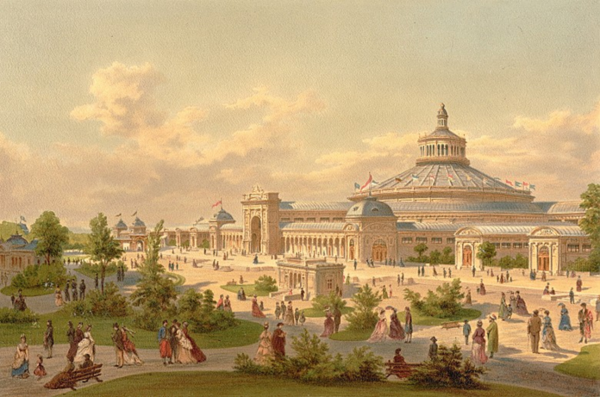
[아츠앤컬쳐] 150년 전, 비엔나 만국박람회가 열렸다. 이 인상적인 전시회를 기억하기 위해 비엔나는 전시장 일대를 그린 사진과 엽서를 기반으로 3D 가상 현실을 만들어 제공했다. 비엔나 만국박람회는 황제 요제프 2세가 1766년에 비엔나 주민들에게 휴양지로 기증한 옛 황실 사냥터 ‘프라터’에서 열렸다. 총 233ha 중 16ha에 건설되었는데 이전 파리 만국박람회의 약 5배 크기였다. 그 한가운데 거대한 산업 전시관에서도 대표적인 중심은 철제 중앙 건물인 ‘로툰다’였다.
총감독 슈바르츠-센본은 1845년 오스트리아 무역박람회에 에두아르드 반 데어 뉠 등이 개발한 ‘헤링본 시스템’을 사용하여, 길이 905m, 너비 25m의 종형 갤러리에 16개의 갤러리가 가로지르도록 교차시켰다. 그 결과 넓은 중정에 높은 측광으로 전시실을 비추고 환기도 잘 되었다. 추가 전시 공간을 확보하기 위해 나중에 그 중 많은 부분을 지붕으로 덮었다. 최종적으로 직사각형 안뜰이 있는 두 개의 건물이 서쪽과 동쪽의 홀을 막았다.
이 전시관은 넓은 건물에 필요한 다양성을 제공하고 밖에서 안을 들여다볼 수 있도록 지리적 배치가 잘 이루어져 있다. 이곳은 물품 이동이 편리할 뿐만 아니라 방문자가 이미 방문한 곳으로 돌아갈 필요 없이 개별 섹션에 직접 접근할 수 있도록 되어 있다. 가로 갤러리 전면에 있는 32개의 출입구와 4개의 대형 주요 포털을 통해 총 7ha에 달하는 산업 전시관으로 접근이 가능하다.
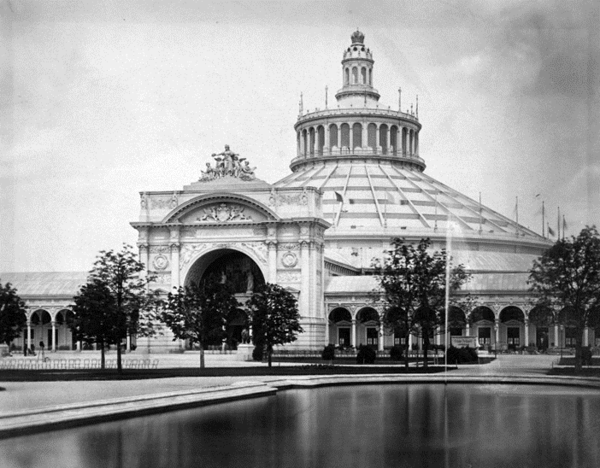
산업 전시관 중앙의 대표적인 건물 ‘로툰다’는 당시 세계에서 가장 큰 돔 건물이었다. 날개 길이도 108m로 로마 베드로대성당의 2배가 넘는다. 그러나 처음에는 비엔나 사람들이 그 건물을 비난하며 ‘썩은 금속 언덕’, ‘비엔나 케이크’ 또는 ‘치즈 덮개’와 같은 이름으로 불렀고, 전문가들과 정치인들도 회의론을 제기했다. 막스 노르다우는 늑골이 있는 지붕을 ‘거북이 등껍질’로, 비엔나시장 카제탄 펠더도 “말할 수 없을 정도로 어설픈 지붕”이라며 별로 좋아하지 않았다. 로툰다는 비엔나사람들 사이에서 농담거리가 되어 빠르게 퍼져나갔다.
로툰다는 영국 해군 건축가 존 스콧 러셀이 설계했다. 전등갓 모양의 원형 홀 지붕은 32개의 철제 기둥 위에 놓였다. 여기에 철 약 4,000t이 들었고, 직경 4m, 무게가 거의 4t에 달하는 거대한 금박을 입힌 황실 왕관이 꼭대기에 얹혔다. 완공된 건물은 27,000명이 넘는 사람들을 수용할 수 있었다.
1873년 이후 로툰다는 철거에 상당한 비용을 초래하고 무분별한 파괴로 물의를 빚을까 염려하여 살아남았다. 그동안 슈테판대성당과 함께 비엔나의 두 번째 랜드마크가 되었으며 1937년 화재로 소실될 때까지 수십 년간 다양한 행사가 거행되었다.
전시 면적: 233ha / 방문객: 725만5천 명 / 참가국: 35개국 / 전시업체: 5만3천 업체 / 전시 기간: 1873년 5월 1일~11월 2일
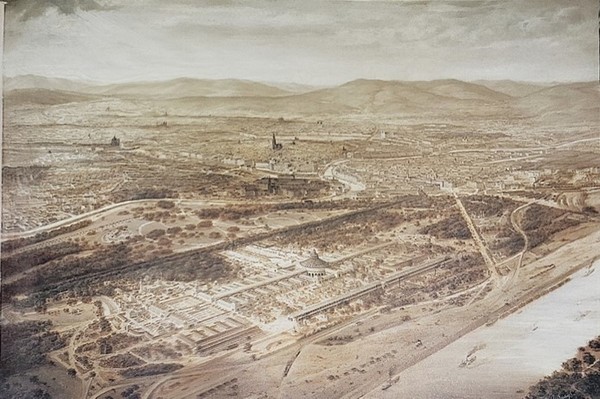
INDUSTRIAL PALACE WITH ROTUNDA – A TECHNICAL MASTERPIECE
150 years ago, the Vienna World Exhibition took place. As remembering of this impressive exhibition, Vienna provided to create a 3 D – Virtual Reality based on photographs and Postcards showing the pavilions and surroundings.
The Vienna World Exhibition was located at the Vienna “Prater”, the former imperial hunting ground, which Emperor Josef II had already donated to the Viennese population as a recreation area in 1766. This area had a total area of about 233 hectares, of which 16 hectares were built. The area was about five times the size of the previous world exhibition in Paris. The center place was “The Industrial Palace” with its enormous dimensions. Its representative centre was an iron central building: “The Rotunda”.
General Director Schwarz-Senborn had used the "Herringbone System" developed by Eduard van der Nüll and August Sicard von Sicardsburg for the Austrian Trade Exhibition in 1845 and had it modified accordingly. A 905 meter long and 25-meter-wide longitudinal gallery was built, which was intersected by 16 transverse galleries. The resulting wide courtyards enabled the exhibition rooms to be illuminated by high side light and provided sufficient ventilation. Two final buildings with rectangular courtyards closed off the hall in the west and in the east.
The pavilion system followed here provided the desired variety for such an extensive building and made the inner structure visible from the outside. The geographical arrangement of the exhibiting countries could thus be done best. This facility not only facilitated the transport of the objects to and from the hotel, but also allowed visitors direct access to individual sections without having to return to rooms they had already visited. 32 entrances and exits on the front sides of the transverse galleries and four mighty main portals offered access to the Industrial Palace, which occupied a total area of 7 hectares.
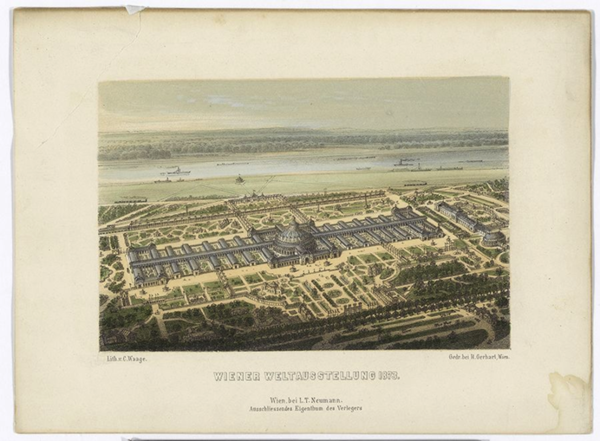
The representative “Rotunda” in the center of the Industrial Palace was the largest domed building in the world at its time. Its wingspan of 108 meters was more than twice as wide as that of St. Peter's Basilica in Rome. Initially, however, it aroused astonishment among the Viennese population, who rejected the striking building and gave it names such as "Blechhaufen"(rotten metal hill), "Guglhupf"(a Viennese cake) or "Käseglocke"(cheese cover). There was also scepticism among experts and politicians. Max Nordau reminded the ribbed roof of "the back shell of a turtle", and the mayor of Vienna, Cajetan Felder, also took little pleasure in the "clumsy roofing beyond all description". The rotunda quickly became a popular object of the Viennese joke sheets.
The rotunda was designed by the English naval architect John Scott Russell. The lampshade-shaped roof of the rotunda rested on 32 iron columns. The total iron weight of the rotunda was about 4,000 tons. A huge gilded imperial crown four meters in diameter and weighing almost four tons was emblazoned on the top of the rotunda. The finished building offered space for over 27,000 people.
After 1873, the Rotunda was only destined to survive because its demolition would have caused significant costs and the senseless destruction would probably have caused a sensation. In the meantime, it has become Vienna's second landmark alongside St. Stephen's Cathedral, and for decades it served for a wide variety of events until it was destroyed by fire in 1937.
Exhibition Area: 233 ha / Visitors: 7.255.000 / Countries 35 countries / Exhibitors: 53.000 exhibitors
Opening: 1. May 1873 Closing: 2. November 1873
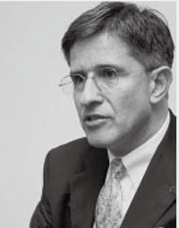
글 | 볼프강 슬라빈스키 Wolfgang Slawinski
서울명예시민
한·오스트리아협회 부회장

